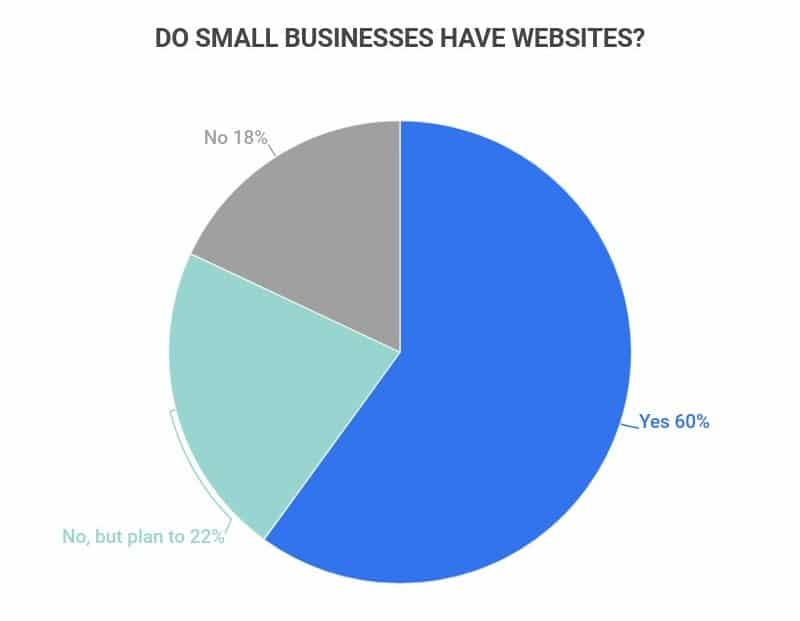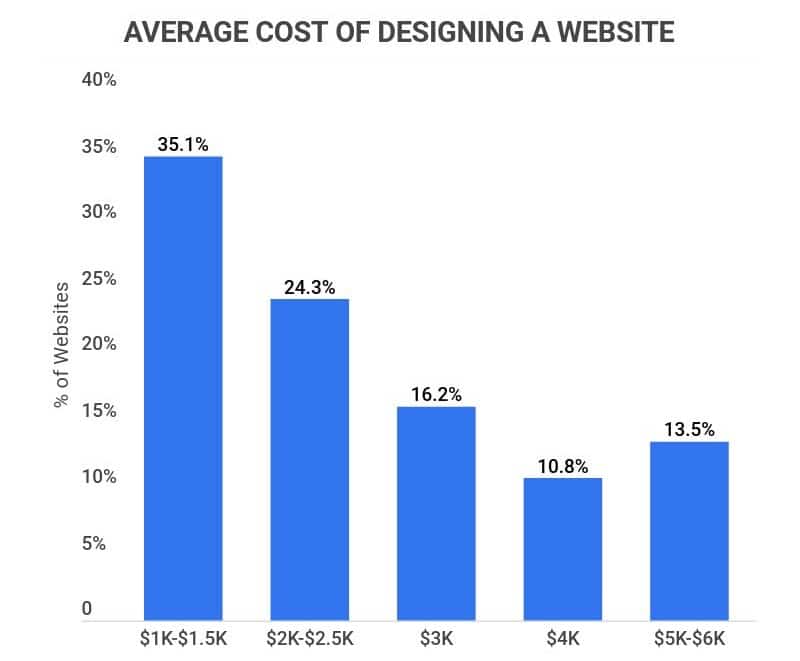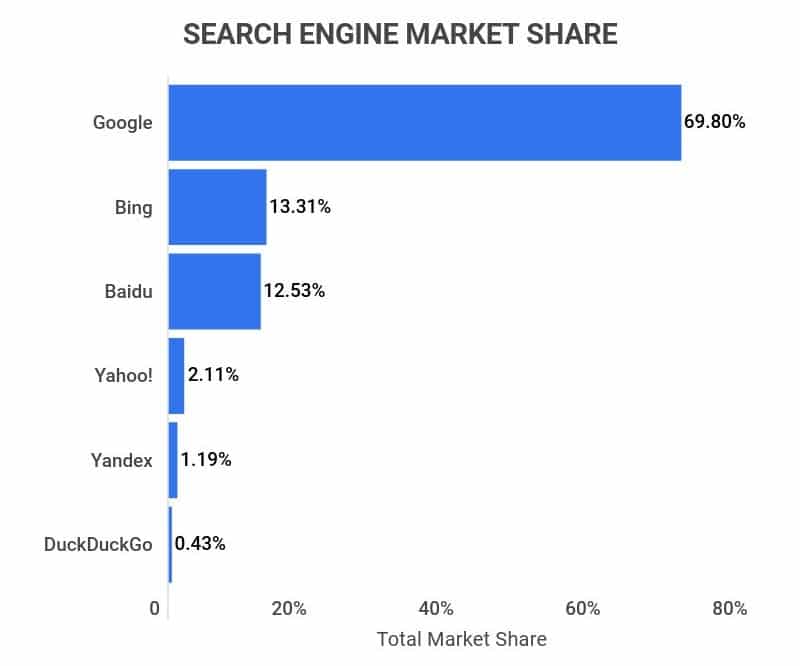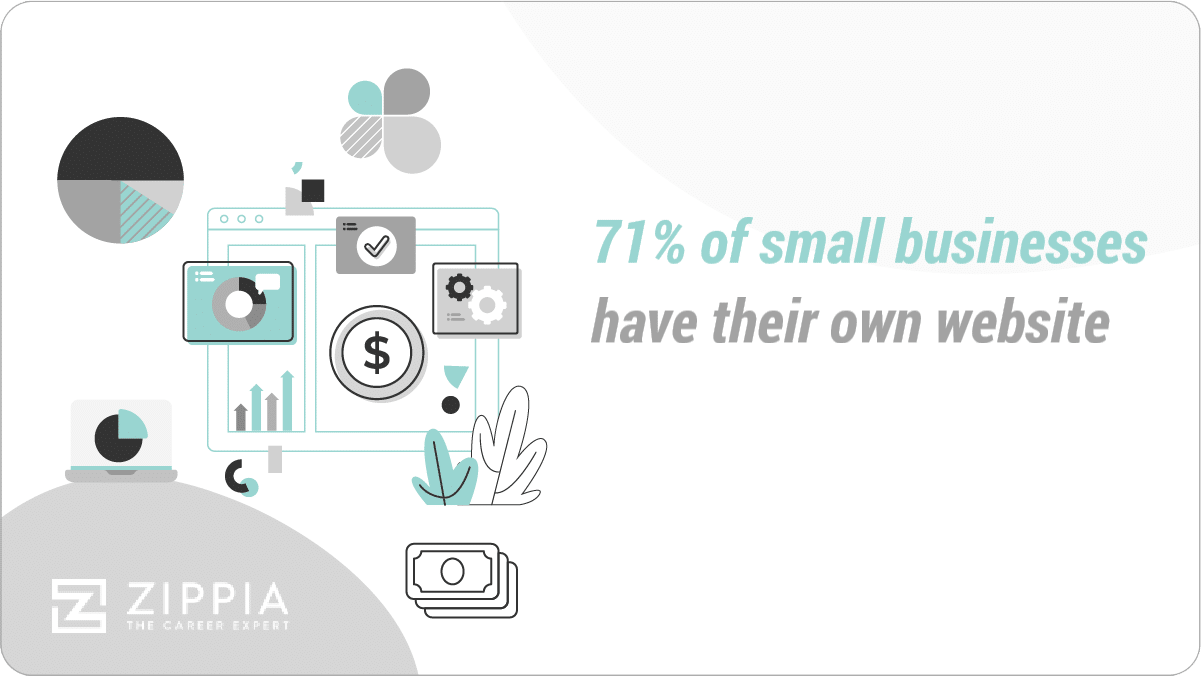Research Summary. As more and more Americans are coming online to order food, buy essentials, and look for the perfect custom birthday present, small businesses also need to go online to stay competitive. When it comes to the number of small businesses that have websites, our research shows that:
-
71% of small businesses have their own website.
-
81% of shoppers choose to research a business online before making a purchase, with 55% searching for online reviews and 47% searching for the business’ website.
-
On average, starting a website for a small business costs anywhere between $2,000 and $10,000.
-
Roughly 85% of consumers use the internet to discover and find local businesses.
For further analysis, we broke down the data in the following ways:
Return on Investment | Local Traffic | Website User | Mobile vs. Desktop

Statistics on Small Businesses Without Websites
While many small businesses have adopted websites, a considerable amount still doesn’t use them. Considering how many people rely on the internet in 2021, this can negatively affect a business. Here are the facts:
-
At least 29% of small businesses don’t have a website.
However, 44% of small business owners plan to create a website in 2021. The lack of websites among small businesses is because of how expensive it can be to create a new website. Many businesses worry that if website traffic is low, they will be unable to make their money back.
-
40% of small businesses don’t want a website.
And a further 28% say they likely won’t want one in the future. The main reasons cited for this lack of interest are that: their business is too small, they can use social media instead, or that a website is too expensive to be worth it.
-
Over 20% of small businesses use Social Media in place of a website.
That means 1 in 5 small businesses rely on social media for their online traffic. While the clear benefit of social media is that it’s free, it also limits lead generation, diminishes branding, and lacks credibility.
-
27% of small businesses believe a website isn’t relevant to their industry.
While a further 26% don’t like the cost associated with a website, and 15% simply feel they lack the technical knowledge to create or operate a website themselves.
-
35% of small businesses feel as though their business is too small to warrant a website.
And this also relates to cost, as many worry the cost of a new website will not be made up by the number of people who discover or purchase from their website.

Small Business Website Return on Investment Statistics
For the 71% of small businesses who do invest in a website, what are the returns? After all, no one would make websites if there weren’t benefits. Here are the insights our research uncovered:
-
66% of small businesses spend less than $10,000 designing, building, and launching their website.
That means most small business owners aren’t spending the top-end price for web development, which also makes the website more financially solvent. In fact, many businesses can afford to create a website on a budget of $1,000-$3,000 if they make use of freelancers.
-
As of 2020, e-commerce sales account for 18% of all retail sales worldwide.
Overall, retail e-commerce sales reached $4.89 billion globally, a whopping 73% from $1.33 billion in 2014. With that in mind, websites are becoming more important than ever.
-
54% of Americans use their mobile phones to shop online.
With over half the country using their phones to shop, a website can make it much easier to reach shoppers. A website connected to social media or a mobile-friendly interface stands a much higher chance of producing traffic and sales.

Small Business Website and Local Traffic Statistics
A website is meaningless if it doesn’t have any traffic. For any small business, it’s important to bring website traffic up to offset the initial cost. Here are the facts:
-
Roughly 85% of consumers use the internet to discover and find local businesses.
Therefore, even if you have a brick-and-mortar shop, your discoverability becomes much higher as 34% of consumers search the internet every day to find local businesses, and 46% of all Google searches are local.
-
Around 70% of website traffic starts with Google.
That means that Search Engine Optimization (SEO) is crucial for any website, as most customers will find the website through a search engine. After all, SEO is directly connected to search engine search queries, which accounts for 40% of website traffic.
-
At least 78% of location-based mobile searches result in an offline purchase.
Of which, 18% lead to a purchase within one day. And even more dramatically, 72% of customers who make a local search end up visiting a store within five miles.
-
62% of consumers share online deals with their friends.
Even further, 81% prefer to trust the advice of family and friends over businesses. That means your most important form of marketing could be reviews and recommendations.

Small Business Website User Statistics
For obvious reasons, how a user feels about your website can significantly impact how effective the website is. After all, customers won’t learn anything about your business if they can’t figure out how to navigate the site. When it comes to website users, our research shows that:
-
38.5% of website visitors form their opinion of a business based on initial user experience.
First impressions are everything, and that’s especially true for over a third of website users. For these individuals, the poor design drives them away from using a small business’ website.
-
A considerable 76% of buyers are willing to share their personal information in exchange for a white paper.
Meaning that this is the kind of content many users are interested in. 79% of B2B buyers agree that white papers were the type of content they’d be most eager to share with their coworkers.
-
38% of customers will stop engaging with a site if it doesn’t have an appealing layout.
In part, this is due to the sheer amount of choice consumers have on the internet. If they don’t like one site, they can easily turn to another. For this reason, the cosmetics of a website can be just as important as the actual information or products.
-
Almost 40% of users will disengage from a slow website.
Slow websites are such a huge problem that conversions will drop 20% per second of site load time! Most users expect no more than 2 seconds of load time, which means it’s vital to keep your website running quickly and smoothly.
-
Users spend 88% more time browsing web pages with video content.
More than any other feature, users will spend the most time on web pages with video content. That means that quality videos about your brand, products, or other relevant topics will keep users on your website.

Mobile vs. Desktop Small Business Website Statistics
Given that 54% of Americans use their smartphones to shop online, it’s important to understand the difference between mobile and desktop website visits. Here are some prominent mobile vs. desktop trends, according to our research:
-
Consumers have 2X more interactions with brands on mobile than they do on desktop.
This holds true for any other form of media as well. Whether it’s TV, in-store, or desktop, customers will interact far more with brands on their phones. This highlights the ever-growing importance of apps.
-
In the U.S., desktop has a conversion rate of 3.99%, compared to only 1.22% on mobile.
And this trend carries over for all forms of online shopping as well, with the average mobile add-to-cart rate being 10.4%, which is less than the 12.9% for desktop. Overall, consumers are more likely to buy products on desktop than on mobile.
-
As of 2020, 61% of U.S. website traffic comes from mobile devices.
Despite having a smaller conversion rate, most website traffic comes from mobile devices. On the other hand, only 35.7% of visits come from desktops.
Small Business Website FAQ
-
What percentage of small businesses don’t have websites?
29% of small businesses don’t have a website. Generally speaking, the main reasons businesses don’t have websites include the idea that their business is too small, that they can use social media instead, and that a website is too expensive to be worth it.
Overall, 40% of the businesses that don’t have a website don’t want a website either. A further 28% also have no intention of getting a website in the future.
-
How many small businesses have websites in 2021?
71% of small businesses will have websites in 2021. And, it’s not hard to understand why, as 18% of all retail sales worldwide now happen online. Plus, even if a business doesn’t sell online products, websites can still aid in sales and discovery.
In fact, one of the biggest benefits of having a website is local discovery, as 85% of consumers use the internet to discover and find local businesses.
-
Why does a small business need a website?
Small businesses need a website because website traffic can increase online and offline purchases. For instance, at least 78% of location-based mobile searches result in an offline purchase. On top of that, 54% of Americans use their mobile phones to shop online, a large portion of the market.
Overall, websites are necessary to increase the discoverability of your small business and spread the word when you receive positive feedback from customers.
-
What percentage of consumers research a business online before using their services?
81% of consumers research a business online before using their services. This means that having an online presence is a vital step in wooing customers to your business, whether they end up doing that in person or online.
55% of these shoppers who do online research before making a purchase look for online reviews of businesses that they’re thinking about making a purchase from, and 47% will look up the company’s website.
Even though having a website has been proven to be a valuable marketing tool for small businesses, 29% of them still don’t have a website. In addition, 40% don’t want a website, and 28% say they don’t think they’ll ever want one.
Some of the reasons small business owners give for this include believing that their business is too small, that a website is too expensive, or that social media will do the same thing as a website will. Others feel that a website isn’t relevant to what their business does or that they wouldn’t know how to create and maintain a website.
-
What percentage of business websites have a blog?
Over 65% of business websites have a blog. While there is no official statistic saying exactly how many business websites have blogs on them, 65% of businesses say that blogging is their most-used content marketing format, the most of any category. This means that at least 65% of companies that do content marketing have to have blogs on their websites.
Now, while many content marketers are trained to produce as much bite-sized, social media-friendly content as possible, the truth is that customers also want helpful, long-form content, demonstrated by the fact that 76% of customers are willing to trade their personal information in exchange for a white paper.
In addition, regularly releasing blog posts helps improve your business website’s SEO ranking, which means Google will rank your website higher when people search for something related to your business. This is important because about 70% of website traffic starts with Google, and search engine queries account for 40% of website traffic.
Conclusion
The isolation of the COVID-19 pandemic highlights just how much we’ve begun to rely on the internet for discovery, information, and purchases. Due to this, it’s no surprise that most small businesses now have their own website.
However, 29% still don’t, with many of their businesses also believing they’d be better without. The sheer amount of competition on the internet can make it difficult for many businesses to justify the cost of creating a website.
Competition does matter, as websites with unappealing layouts or slow loading times can see upwards of 40% of their users tune out. Efficiency and aesthetics are everything when it comes to websites.
Regardless, having a website is still vital in the digital age, and in many cases, can lead to more people discovering and consuming your products. After all, 85% of customers use the internet to discover businesses, and up to 78% of location-based mobile searches result in an offline purchase.
References
-
Cision. “28% of Small Businesses Don’t Have a Website, According to New Survey Data.” Accessed on November 10th, 2021.
-
HRDrive. “40% of small businesses don’t have a website, survey finds.” Accessed on November 10th, 2021.
-
The Manifest. “9 Risks and Rewards of Using Social Media Instead of a Website.” Accessed on November 10th, 2021.
-
Small Business Trends. “66% of Businesses Spend Less Than $10K to Build Their Website.” Accessed on November 10th, 2021.
-
Statista. “E-commerce worldwide – statistics facts.” Accessed on November 10th, 2021.
-
Statista. “Mobile commerce sales as percentage of total retail sales in the United States from 2018 to 2025.” Accessed on November 10th, 2021.
-
Digital. “10 Key Benefits of a Website for Small Businesses.” Accessed on November 10th, 2021.
-
Net MarketShare. “Search Engine Market Share.” Accessed on November 10th, 2021.
-
Think with Google. “Understanding consumers’ local search behavior.” Accessed on November 10th, 2021.
-
Transaction. “81% of Consumers Trust the Advice of Family and Friends Over Businesses.” Accessed on November 10th, 2021.
-
GoodFirms. “Website Design Stats And Trends For Small Businesses – GoodFirms Research.” Accessed on November 11th, 2021.
-
Crowdcontent Blog. “The 3 Types of White Papers – And Why You Should Care.” Accessed on November 11th, 2021.
-
Slideshare. “2018 Adobe Consumer Content Survey.” Accessed on November 11th, 2021.
-
NeilPatel. “How Loading Time Affects Your Bottom Line.” Accessed on November 11th, 2021.
-
Strother Communications Group. “B2B Simplified.” Accessed on November 11th, 2021.
-
Think with Google. “How to make every mobile moment a brand-builder.” Accessed on November 11th, 2021.
-
WebFX. “Desktop vs. Mobile: Which Converts Better? [Infographic].” Accessed on November 11th, 2021.
-
Perficient. “Mobile vs. Desktop Usage in 2020.” Accessed on November 11th, 2021.





